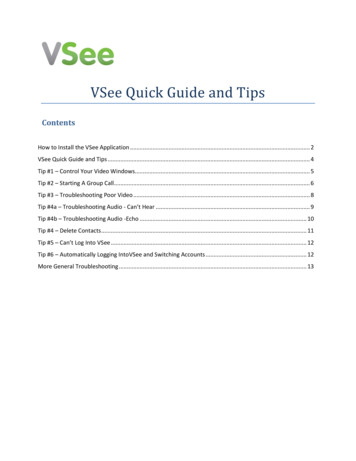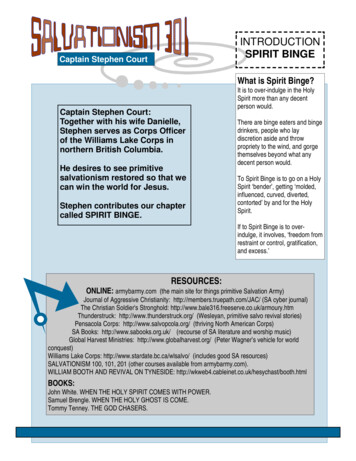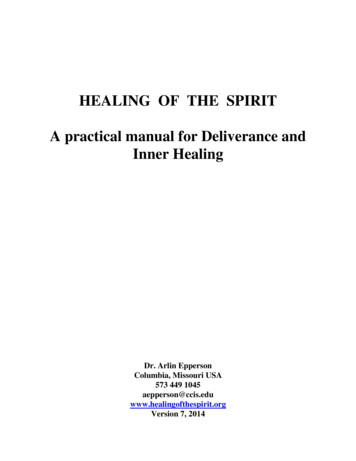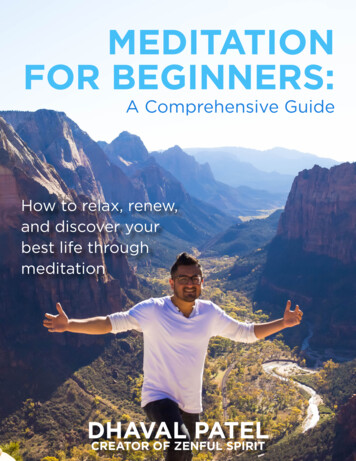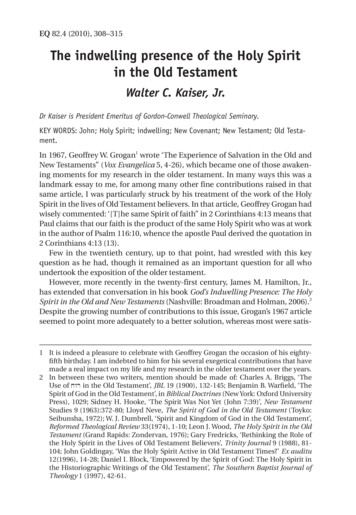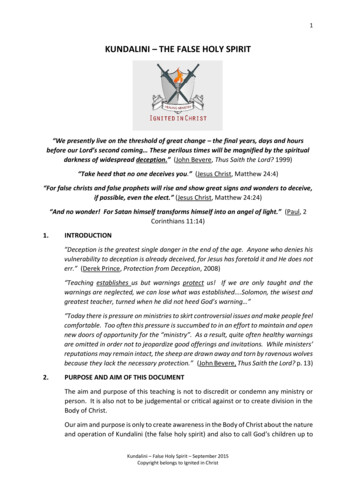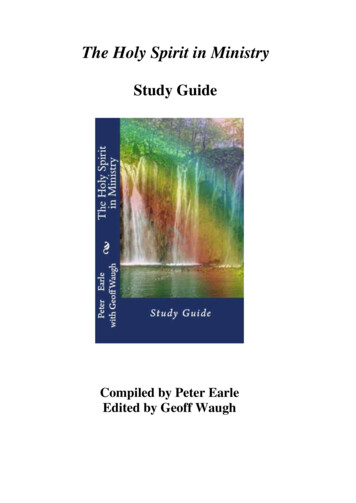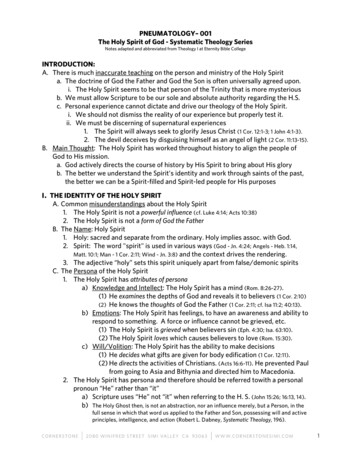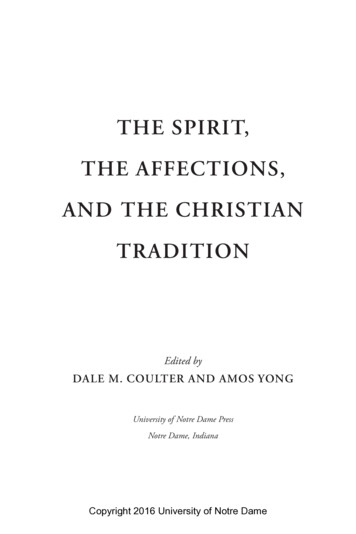
Transcription
THE SPIRIT,THE AFFECTIONS,AND THE CHRISTIANTRADITIONEdited byDALE M. COULTER AND AMOS YONGUniversity of Notre Dame PressNotre Dame, IndianaCopyright 2016 University of Notre Dame
P R E FAC EThis collection derives from ongoing discussions between the editorsabout how to develop the theoretical underpinnings of renewal Christianity for the study of Christian history and the history of Christian theology. Each of us has either taught in (Amos) or continues to teach in(Dale) the relatively new and emerging field of renewal studies, uniquelysituated at Regent University School of Divinity. Regent University itselfis deeply shaped by neo-pentecostal and charismatic renewal, leading in2003 to the establishment of a PhD program in the School of Divinitywith a methodological focus on renewal and renewal movements in thehistory of Christianity.Because of the history of the institution in which this program issituated, its central focus has always been the global pentecostal and charismatic renewal. Yet the seminary is also explicitly transdenominational,broadly evangelical, and even ecumenical in its ethos, including facultyand students from Protestant, Catholic, and Orthodox traditions. Whatbinds together faculty and students is a shared commitment to promoting the renewing work of the Holy Spirit.Hence, while renewal studies surely includes the pentecostal andcharismatic movements derived from the Azusa Street revivals at the beginning of the twentieth century, it is also much more than that. Thefaculty has adopted an explicitly methodological definition of renewal forits programmatic self-understanding.The Regent University School of Divinity Ph.D. program understands Renewal Studies as a methodological approach to global Christian engagement with discourses in the academy, church, and worldas informed by critical reflection derived from charismatic movements and their practices throughout the history of God’s people.ixCopyright 2016 University of Notre Dame
xPrefaceNote here that renewal is not reducible to the twentieth-century pentecostal or charismatic revivalist traditions; rather, it is committed to researching, studying, and reflecting on charismatic renewal movements“throughout the history of God’s people”—which means not only going“behind” the twentieth century to the broader history of Christianity, butalso behind the first century into the history of ancient Israel. As one OldTestament faculty member pointed out, the main plot lines of the Hebrew Bible are also uniquely shaped by themes of renewal, restoration,and revitalization.How then to theorize renewal in the history of Christianity and thefield of historical theology? More precisely, how does foregrounding therenewing work of the Holy Spirit shape scholarship in these arenas? Whatkinds of research projects and questions emerge when such a renewalistand pneumatological lens is focused historiographically in these areas?One such area was the intersection between the divine and human inthe Christian notion of salvation. To put it in Gerhart Ladner’s terms, itmeant a return and deeper exploration of the idea of reform within thehuman person through a specific focus on the affections. The benefit ofthis area was that it opened up a broader exploration of moral psychology, the erotic and ecstatic dimensions of the divine-human encounter,and the development of notions of affectivity in the history of Christianity. The chapters in this book offer some preliminary analyses of thesetopics in the context of an “ecumenical” exchange of ideas about theChristian tradition that draw on a range of discourses in the academy.Many of the chapters in this book were first presented as special lectures at Regent University in 2011–12 or as plenary presentations at ourconference “The Holy Spirit and the Christian Life,” held March 1–2,2013. We are grateful to former School of Divinity deans Michael Palmerand Tammie Wade for supporting the lectureships and the conferenceand to Wolfgang Vondey, former director of the Regent University Centerfor Renewal Studies, for hosting them. Thanks also are due to the Schoolof Divinity staff and graduate assistants who helped with the events: KatieLohmann, Robert Smith, and Vince Le. Enoch Charles, Paul Palma, andDonald Bufford, other graduate assistants, also worked hard on the formatting of the book. Hoon Jung, Amos’ graduate assistant at Fuller Theological Seminary, helped with the indexing of the volume.Copyright 2016 University of Notre Dame
Preface xiLast but not least, the staff at the University of Notre Dame Press alsodeserve kudos: Charles Van Hof, Robyn Karkiewicz, and Stephen Littleand their team have been great to work with. Two anonymous reviewersfor the Press helped strengthen the chapters and connect the dots. Needless to say, we as editors are indebted to our authors for their contributions in the following pages.The editors dedicate this volume to our former colleague, Dr. Stanley M. Burgess, recently retired from the School of Divinity. Stan, an encyclopedist extraordinaire of contemporary renewal movements, has longbeen at the forefront of asking what we call renewalist and pneumato logical questions regarding Christian historiography, and he was instrumental in helping establish the PhD program at the School of Divinity.His ongoing scholarly output remains a staple for students in the historyof Christianity doctoral track. Stan has been a mentor and exemplary renewal scholar and scholar of renewal. We trust that this volume, only asmall token of our appreciation for his work, will be received as the meager complement to his oeuvre that it is intended to be.Copyright 2016 University of Notre Dame
I N T RO D U C T I O NThe Language of Affectivity and the Christian LifeD A L E M . C O U LT E ROver the past several decades there has been a virtual renaissance in thestudy of emotion and desire occurring in different disciplines and for diverse purposes.1 Part of the challenge of this resurgence is that many ofthese scholarly trajectories remain confined to particular traditions of inquiry or religious traditions without significant interaction.2 There is aneed to bring together investigative analyses that span historical periods,Christian traditions, and scholarly agendas, which this current volumeattempts to do. The chapters in this volume offer a more or less chronological exploration of affectivity within Christian tradition by scholarswho inhabit different parts of that tradition. It is the most straightforwardway to follow various developments within the tradition. In this sense, asa whole, this volume represents an initial effort at a kind of ecumenicaland interdisciplinary conversation through ressourcement.What results from this endeavor is not only a closer inspection of affectivity in relationship to inward change and the work of the Spirit butalso what may be termed a renewal historiographical lens. As a burgeoning approach, renewal historiography underscores the methodological1Copyright 2016 University of Notre Dame
2Dale M. Coulterimport of sensitivity or orientation to the charismatic dimension of Christian existence that informs the critical reading and interpretation oftexts and ideas. This basic understanding branches out into three generalareas of concern for those engaged in “renewal studies”: (1) the historicalphenomena surrounding and giving rise to social and ecclesial reform andrenewal, including a focus on religious populism and popular modes ofcommunication; (2) the role of the charismatic in relation to internal renewal that facilitates ongoing conversion; and (3) theological reflectionupon the Holy Spirit as the central factor in such an encounter. Whilenot all the writers in this volume consciously operate by means of thismethod, as Amos Yong’s conclusion attempts to demonstrate, their contributions collectively exemplify the interpretive sensibilities and modalities embodied in it.All religious traditions experience periods of decline in which thefoundational ideas become blurred or the growth of the religion stagnates.On the social level, “renewal” refers to the way in which movementswithin religions recover central concerns that revive the commitment ofindividuals and propel the tradition into further phases of growth. Suchrenewal movements more often than not derive from the forms and concerns of populist religiosity, which subsequently gives rise to deeper theological reflection. This reflection can remain at the level of “folk theology”or spirituality, such as the advice of John Climacus, the visions of Hade wijch of Brabant, or the sermons of John Wesley. It can also exist in thetradition’s basic religious or liturgical practices. Several of the chapters inthis volume thus explore affectivity in the folk theologies and spiritualities of important writers, thereby underscoring the importance of sensitivity to religious populism as part of a renewal approach. Moreover, withchapters directed to the nonspecialist, this volume also embodies popularmodes of communication that a renewal method attempts to exemplify.Some chapters are more general, and others dive deeply into affectivity;nevertheless, all retain the nonspecialist approach. Thus this volume seeksto contribute to the renewal of the study of affectivity, as well as retain asensitivity to forms of populist religiosity that have given rise to movements of renewal and folk theologies.Christian existence has as its central concern the salvation of thehuman person through an inward renewal that both heals and elevates theCopyright 2016 University of Notre Dame
Introduction3soul. While this conversio to God as the final end occurs in the cognitiveand affective dimensions, it is the latter that became the focus of Christian writers. Personal renewal was associated with practices that integratedthe reorientation of human love, the therapy of desire, and the encounterwith God through the Spirit in its sanctifying and charismatic dimensions. With its goals of ecstatic embrace and union, the mystical life attested to the fusion of the charismatic, internal transformation and affectivity. Ecstasy, in particular, referred to modes of charismatic encounters as well as sanctifying moments. Many of the chapters in this volumeexplore how particular writers in the tradition understood this relationship, revealing how a sensitivity to the charismatic can provide a new window onto the development of Christian ideas about the affective life.By retrieving the complex discussion about affectivity in Christiantradition and bringing its diverse voices into dialogue in a contemporaryecumenical context, these chapters also point toward a number of research trajectories that fill out the picture of a renewal method and needfurther exploration. One particularly important theme that emerges fromthe whole is the need to get back behind the shift in the analysis of emotion and desire that occurred in the late eighteenth century. From theemergence of a “sentimental culture” that McClymond highlights toClapper’s desire to tame the dominance of a “feeling” theory of the emotions, several chapters address the conceptual challenges that arose at theturn of the nineteenth century. In addition, they illuminate the diachronic shifts in the language of affectivity, which remains an importantarea of further investigation. They point to the need for additional workon the psychology of conversion as a feature of charismatic existence, especially with respect to analyses of sin and salvation as a therapeutic enterprise in which the Spirit heals and empowers the soul. Finally, severalchapters underscore how probing the role of affectivity in relation tounion with God, ecstasy, and the erotic remains important throughoutChristian tradition.This introduction sets the tone for the chapters that follow by brieflynoting research trajectories on affectivity in the past forty years, exploringdevelopments in the terms used to describe the affective life, and identifying the important ideas that flow through the book as a whole.Copyright 2016 University of Notre Dame
4Dale M. CoulterResearch on AffectivityThe past three decades have witnessed a proliferation of studies reexamining the intellectual history of affectivity. In many respects, Robert Solomon’s argument in 1976 that emotions are constituting judgments thatshape human identity and supply meaning to life launched a discussionof the philosophy of emotion in Anglo-American circles.3 Central toSolo mon’s project has been an effort to overcome the divide betweenemotion and rationality as though the former has little to do with thelatter. Simultaneous with this development and influenced by it, a retrieval of ancient philosophical views on the emotions began in the late1970s that set the stage for a deeper exploration of emotion in relationto human flourishing and the therapy of desire.4 The use of historicalanalysis in constructing philosophical accounts of emotion and their relationship to human action and flourishing has now become a cottage industry with a body of literature so large that it is difficult to keep pace.The resurgence of cognitivist accounts of the emotions has opened thedoor to studies in diverse historical periods as well as those of an interdisciplinary nature.Within scholarship specifically devoted to an exploration of theChristian tradition, there are similar trends at work. In the past decadealone a number of studies have appeared that trace out broader trends inChristian writers and their efforts to provide accounts of emotion and desire in light of the Christian doctrines of sin and salvation and the psychology of conversion. Some studies, such as Simo Knuuttila’s, followRichard Sorabji by analyzing philosophical accounts of emotion and desire in ancient and medieval thinkers.5 Representing a second approach,Thomas Dixon has argued that the history of emotion in the West involves a slow separation of theological and philosophical accounts buttressed by the rise of psychology and the “feeling” theory of WilliamJames.6 Thomas Dixon describes this “feeling” theory as involving a turnto more materialist accounts in which emotions are visceral and involuntary movements that begin in parts of the body and are felt passively.7Dixon’s work affirms Solomon’s desire to recover cognitivist accounts ofemotion by offering a critique of the historiography supporting that ac-Copyright 2016 University of Notre Dame
Introduction5count. Whereas Solomon had argued that the antagonism between emotion and reason stemmed from antiquity, Dixon counters that it wasprimarily a result of nineteenth-century developments. What emergesfrom studies like Knuuttila’s and Dixon’s is that Christian thinkers hadcomplex discussions of emotion and desire that tracked more with viewsof emotion as cognition rather than of emotion as feeling.8There have also been studies that focus on a cultural history of emotion and how diverse communities understood the roles that emotionsplay. Barbara H. Rosenwein’s work, for example, examines the early Middle Ages with a focus on how communities describe and shape emotionallife.9 More specifically, she attempts to counter Nussbaum’s overly negative assessment of medieval ideas about emotion. As Dreyer’s chapter inthis volume indicates, analyses like Rosenwein’s combine a focus on spirituality, gender, the body, and mysticism.10 The result of such studies is toreveal a deeply affective piety in the Middle Ages with broad cultural rootsthat hold together the Occitania culture of the troubadours and fin’amor,the rise of courtly love in Anglo-Norman culture, and the spirituality oflove characteristic of male and female medieval religious writers. To studythis history of emotion scholars must wrestle with notions of ecstasy, theerotic, love, and union with God more than with philosophical accountsof emotion and desire.Finally, a number of trajectories have emerged in the past several decades that study emotion and desire in the context of a specific traditionof Christianity. His effort to capture John Wesley’s focus on experienceled Theodore Runyon to coin the term orthopathy to describe how rightaffections fuse right beliefs (orthodoxy) and right practices (orthopraxis)within Wesley’s thought.11 Runyon’s suggestion was picked up by a number of Wesleyan and pentecostal historians and theologians to describethe dynamics at work within revivalist settings and the connection between divine encounters and the process of Christian development.12Moreover, Samuel Solivan’s effort to bring the transformation of the affections (orthopathos) into dialogue with Latino/a theology has bornefruit among liberation theologians whose interest has been the praxis ofChristian faith.13 These efforts signal a trend across pietist, Wesleyan, andpentecostal traditions of greater attention to the formation of right affections as the center of Christian existence.Copyright 2016 University of Notre Dame
6Dale M. CoulterThe focus on affectivity over a range of studies in Christian scholarship raises the question of pneumatology in a way that challenges prevailing assumptions among constructive theologians about a pneumatologicaldeficit in Western Christianity. These charges began to appear in a seriesof criticisms by Orthodox émigré theologians such as Vladimir Losskyand Nikos Nissiotis, both of whom referred to a Christomonism in Western theology that stemmed at least in part from the perceived implicationsof filioque.14 Sweeping claims to a pneumatological deficit first surfacedin ecumenical dialogue, but these tracked with German concerns overBarth’s focus on Christology, which centered on what Moltmann described as a “forgetfulness of the Spirit.”15 The Orthodox and Germanconcerns found a receptive home in the work of a number of theologianswho became connected with the Research Institute in Systematic Theology at King’s College, London, in the early 1990s and who tended tofavor a social model of the Trinity. Colin Gunton, Robert Jenson, JohnZizioulas, and Christoph Schwöbel, each in his own way, advanced thecriticism. Among these thinkers Gunton’s claims were the most extreme,laying the entire problem at a depersonalizing of the Spirit in Augustine,while Jenson offered a much more nuanced position that saw the problemmore in terms of a failure to emphasize Pentecost as a distinct event coupled with the thirteenth-century shift toward an infused disposition atbaptism (created grace).16 By the early part of the twenty-first centuryVeli-Matti Kärkkäinen could summarize these streams as leading to therecognition that the Western tradition suffered from a deficient pneumatology.17 While the criticisms surrounding filioque have been subjected toa sustained critique, the question of pneumatology in the Western tradition beyond the patristic period remains outstanding.This volume underscores the need for an ecumenical and cross- disciplinary exploration of affectivity in relationship to pneumatologyand the transformation of the human person. Examining the Western tra dition through a renewal lens shows how discourses on the affections became connected to trinitarian discourse because, as Peter Abelard succinctly put it in his Romans commentary, “the gift of God, which [Paul]calls grace, is called the Holy Spirit.”18 Augustine forged a strong connection between grace, love, and the Spirit when he argued that the Spiritformed Christ in the soul by transforming the affective life. For Augus-Copyright 2016 University of Notre Dame
Introduction7tine, original sin is a hardening of the initial disobedient motion in thefirst humans, which is how human nature becomes vitiated.19 The deaththat occurred when grace forsook the original parents resulted in theirbeing bound by their own delight (delectatio) to created realities. As Augustine states elsewhere, “The soul can be changed, not indeed spatially[lo
The Regent University School of Divinity Ph.D. program under-stands Renewal Studies as a methodological approach to global Chris - tian engagement with discourses in the academy, church, and world as informed by critical reflection derived from charismatic move-ments an
